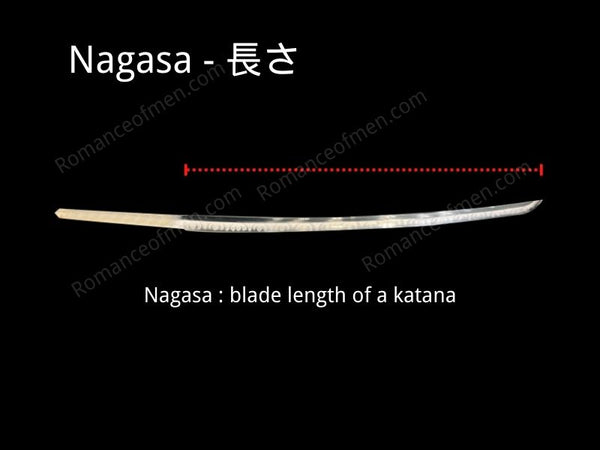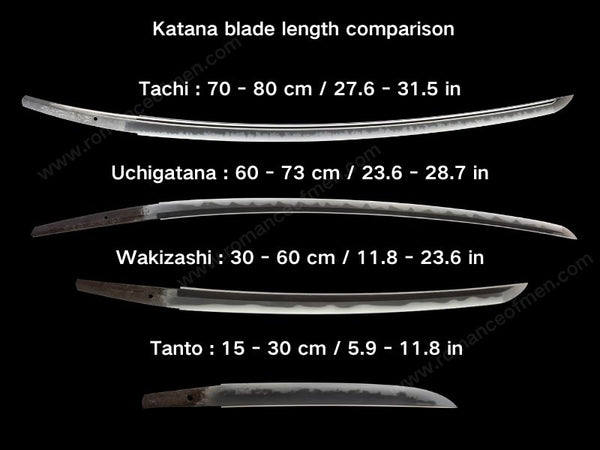Katana Nagasa Know how to measure katana blade the right way
Everything You Need to Know About Nagasa
Nagasa, or the length of the katana blade, is among the most important considerations while buying a Katana. So, if you're planning to buy a Katana soon, you might be curious to know more about this part. This guide will help you in this regard.
Table of Content
- What Is Nagasa?
- How to Measure Nagasa (Katana blade length) Correctly?
- Standard Nagasa (Blade length) for different types of Katana
- Average Nagasa for different types of Katana
- Nagasa History (For Uchigatana)
What Is Nagasa?

Nagasa refers to the blade length of a katana. It's accurate to use it in the context of Katana terminology. However if we want to be 100% correct, We should know that the word "Nagasa"長さ in Japanese means just "length" . But over the years, for non-Japanese speaker, using Nagasa to refer to the blade length has become common, so it's totally fine to use nagasa, because in Katana measurements, blade is always the focus.
The most accurate term for katana blade length should be 刃長 "Ha-cho", where "ha" (刃) refers to the "blade" or "edge," and "chō" (長) means "length." 刃渡 "Hawatari" is another word for "blade length" in Japanese as well.
How to Measure Nagasa (Katana blade length) Correctly?
The blade length of Katana refers to the length from the tip of the blade (kissaki 切先) to the end of the blade (munemach 棟区). Because katana is curved, the correct way to measure it is to draw a straight line from tip to the end, the length of this line is the Nagasa (Blade length).
Traditional Katana Measurements
Traditional katana measurement unit is called Shaku (尺). 1 Shaku equivalent to roughly 30cm (11.8 In), that's about an adult male's forearm length from elbow to fingertip, consider the average height of men during the Edo period was around 155 cm (5 feet 1 inches).
Standard Nagasa (Blade length) for different types of Katana
There are no regulation about the standard blade length nowadays. However, during the Edo period, there was a regulation for katana blade lengths. The law prohibited non-samurai from carrying katana longer than two shaku. as a result, two shaku three sun (about 70cm / 27.6 inc) became the mainstream length for katana.
But this law was not followed by many people. Since each individual's height and arm length vary, it nature that they would require swords with different blade lengths. For example the famous swordsman Miyamoto Musashi who is 182cm (6 feet), his katana's blade length are over 80cm ((32 in) long.
Define your ideal Katana Nagasa (Blade length)
If you practice kenjutsu, Iaido or another katana related martial art, selecting the right size sword is very important. a sword's blade length should ideally matchs the user's height and hand reach, although preferences might differ across various schools and dojos.
A basic formula to estimate the right katana blade length from height is:
(Height in cm * 0.43) / 30.3 = (Right length) Shaku.
For example, a 170cm tall male would calculate his ideal blade length to be approximately 72.7cm (28.6 in) or 2.41 shaku.
For iaido practitioner, to help you find your best length, here is a table indicating the length of the katana corresponding to the individual's height:
| HEIGHT (MALE/FEMALE) | RECOMMENDED BLADE LENGTH (CM/IN) | RECOMMENED HANDLE LENGTH (CM/IN) |
|---|---|---|
| 150 cm ~ 155 cm | 2 shaku 2 sun (66.6 cm / 26.2 in) | 7 sun 5 bu ~ 8 sun (22.7 ~ 24.3 cm / 8.9 ~ 9.6 in) |
| 155 cm ~ 160 cm | 2 shaku 2 sun 5 bu (68.2 cm / 26.9 in) | 7 sun 5 bu ~ 8 sun (22.7 ~ 24.3 cm / 8.9 ~ 9.6 in) |
| 160 cm ~ 165 cm | 2 shaku 3 sun (69.6 cm / 27.4 in) | 8 sun ~ 8 sun 5 bu (24.3 ~ 25.6 cm / 9.6 ~ 10.1 in) |
| 165 cm ~ 170 cm | 2 shaku 3 sun 5 bu (71.2 cm / 28.0 in) | 8 sun ~ 8 sun 5 bu (24.3 ~ 25.6 cm / 9.6 ~ 10.1 in) |
| 170 cm ~ 175 cm | 2 shaku 4 sun (72.7 cm / 28.6 in) | 8 sun 5 bu ~ 9 sun (25.6 ~ 27.3 cm / 10.1 ~ 10.7 in) |
| 175 cm ~ 180 cm | 2 shaku 4 sun 5 bu (74.2 cm / 29.2 in) | 8 sun 5 bu ~ 9 sun (25.6 ~ 27.3 cm / 10.1 ~ 10.7 in) |
| 180 cm ~ 185 cm | 2 shaku 5 sun (75.8 cm / 29.8 in) | 9 sun ~ 9 sun 5 bu (27.3 ~ 28.8 cm / 10.7 ~ 11.3 in) |
| 185 cm ~ 190 cm | 2 shaku 5 sun 5 bu (77.3 cm / 30.4 in) | 9 sun ~ 9 sun 5 bu (27.3 ~ 28.8 cm / 10.7 ~ 11.3 in) |
| 190 cm ~ 195 cm | 2 shaku 6 sun (78.8 cm / 31.0 in) | 9 sun 5 bu ~ 10 sun (28.8 ~ 30.3 cm / 11.3 ~ 11.9 in) |
| 195 cm ~ | 2 shaku 7 sun (81.8 cm / 32.2 in) | 9 sun 5 bu ~ 10 sun (28.8 ~ 30.3 cm / 11.3 ~ 11.9 in) |
Average Nagasa for different types of Katana
Katana means "Single edge sword", is a general term for different types of Japanese swords, even pole weapons like spears (Yari), Nagamaki, naginata are classified as Japanese swords as well. Here we list the nagasa of 4 major types of Katana to give you a better picture of how long they are:

Uchigatana (打刀): A versatile sword with a blade length of 60 to 73 cm (23.6 - 28.7 in), used by samurai for close combat. It's shorter with a total length of 100 to 110 cm (39.4 - 43.3 in).
Tachi (太刀): An older, curved sword for cavalry, with a blade of 70 to 80 cm (27.6 - 31.5 in) and total length of 100 to 120 cm (39.4 - 47.2 in), worn with the edge down.
Wakizashi (脇差): A samurai's sidearm, shorter with a blade of 30 to 60 cm (11.8 - 23.6 in) and total length of 60 to 80 cm (23.6 - 31.5 in), often paired with an Uchigatana.
Tanto (短刀): A short sword or knife with a blade of 15 to 30 cm (5.9 - 11.8 in) and total length of 25 to 50 cm (9.8 - 19.6 in), used for self-defense and everyday tasks.
Nagasa History (For Uchigatana)
Until the early Muromachi period (室町時代), Uchigatana usually had blade lengths of about 40 to 50 cm (15.7 - 19.7 in). From the latter half of the Muromachi period, Uchigatana with blade length exceeding 60 cm (about 23.6 in or 2 shaku) became common. Carrying both a long sword, uchigatana (打刀), and a shorter sword, wakizashi (脇差) together has become a popular trend, across all social classes. Wearing a sword symbolized adulthood for men, transcending social status. The average blade length was about 2 shaku 3 sun 5 bu during the Muromachi period, which was limited to 2 shaku 3 sun 3 bu or shorter after the Taikō's sword hunt (太閤刀狩).
In the Edo period (江戸時代), the law regulated the sword size for different social class. Sword carriers, martial artists, and swordsmanship students were allowed to carry swords with blade length up to 2 shaku 3 sun (approximately 69.7 cm or 27.4 in) under Tokugawa Iemitsu (徳川家光) and up to 2 shaku 2 sun 8 bu (approximately 68.6 cm or 27 in) under Tokugawa Ietsuna (徳川家綱).
Other classes granted permission to carry swords, such as officials, shrine personnel, festival performers, mendicant monks, high-ranking sumo wrestlers, entertainers, and nobility, were limited to 2 shaku 2 sun 3 bu (approximately 67.7 cm or 26.7 in). During the peaceful Edo period, katana were often made for their aesthetic value, leading to blades that were hard but not very flexible, which sometimes broke during rigorous tests like tameshigiri or cutting hard objects.
By the late Edo period, demand grew for practical and sturdy katana. The Sonnō jōi (尊王攘夷) movement's patriots favored long uchigatana with minimal curvature, around 3 shaku (approximately 90.9 cm or 35.8 in) in length, known as Kingo swords (勤皇刀) or Kingo koshirae (勤王拵). Shogunate supporters countered with similarly long swords. Swordsmiths of this time, who produced large, more flexible blades reminiscent of tachi (太刀), are categorized as making revival swords (復古刀).
Conclusion
One can only regard Katana as the most powerful weapon in the world if it's in ideal shape and of the correct length. So, one must carefully choose the Nagasa of the Katana sword while buying. Thanks for reading through. For more katana parts please check this blog.





















